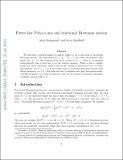Power law Polya’s urn and fractional Brownian motion
Author(s)
Hammond, Alan; Sheffield, Scott Roger
DownloadSheffield_Power law.pdf (311.7Kb)
OPEN_ACCESS_POLICY
Open Access Policy
Creative Commons Attribution-Noncommercial-Share Alike
Terms of use
Metadata
Show full item recordAbstract
We introduce a natural family of random walks S[subscript n] on Z that scale to fractional Brownian motion. The increments X[subscript n] := S[subscript n] − S[subscript n]−1 ∈ {±1} have the property that given {X[subscript k] : k < n}, the conditional law of X[subscript n] is that of X[subscript n−k[subscript n]] , where k[subscript n] is sampled independently from a fixed law μ on the positive integers. When μ has a roughly power law decay (precisely, when μ lies in the domain of attraction of an α-stable subordinator, for 0 < α < 1/2) the walks scale to fractional Brownian motion with Hurst parameter α + 1/2. The walks are easy to simulate and their increments satisfy an FKG inequality. In a sense we describe, they are the natural “fractional” analogues of simple random walk on Z.
Date issued
2012-12Department
Massachusetts Institute of Technology. Department of MathematicsJournal
Probability Theory and Related Fields
Publisher
Springer-Verlag
Citation
Hammond, Alan, and Scott Sheffield. “Power Law Polya’s Urn and Fractional Brownian Motion.” Probability Theory and Related Fields 157, no. 3–4 (December 11, 2012): 691–719.
Version: Original manuscript
ISSN
0178-8051
1432-2064